Summary: A new study reveals the cerebellum’s role in controlling thirst, expanding its known functions beyond motor control. Researchers discovered that the hormone asprosin activates Purkinje neurons in the cerebellum, driving the urge to drink water.
This finding could lead to new treatments for thirst disorders. The study highlights the cerebellum’s broader impact on essential survival functions.
Key Facts:
- Thirst Control: The cerebellum regulates thirst via asprosin-activated Purkinje neurons.
- Non-Motor Functions: This expands the cerebellum’s known roles beyond motor control.
- Therapeutic Potential: Findings could lead to treatments for thirst disorders like polydipsia and hypodipsia.
Source: University Hospitals
The cerebellum, often referred to as the ‘little brain’, has captivated researchers for centuries due to its unique structure and cellular complexity, as one of the most ancient brain regions in evolutionary terms.
It has traditionally been viewed only as a motor control center; however, recent studies have revealed its involvement in non-motor functions such as cognition, emotion, memory, autonomic function, satiety and meal termination.

In a recent mouse-model study, published in Nature Neuroscience, researchers at University Hospitals (UH), Harrington Discovery Institute at UH, and Case Western Reserve University have now found that the cerebellum also controls thirst, a major function necessary for survival.
Specifically, the research team found that a hormone, asprosin, crosses from the periphery into the brain to activate Purkinje neurons in the cerebellum. This leads to an enhanced drive to seek and drink water.
“Asprosin, a hormone our lab discovered in 2016, is known to stimulate food intake and maintain body weight by activating key ‘hunger’ neurons in a part of the brain called the hypothalamus, and works by binding a protein on the neuron surface called a ‘receptor,’” explained Atul Chopra, MD, PhD, senior author on the study, Investigator at Harrington Discovery Institute at UH and Associate Director of the Harrington Rare Disease Program, Attending Medical Geneticist at UH, and Associate Professor of Medicine, and Genetics and Genomics at Case Western Reserve School of Medicine.
A receptor is necessary for a hormone to work, and in the case of asprosin’s ability to control appetite and body weight, that receptor is Ptprd. Besides the hypothalamus, the team found that it is also highly expressed in the cerebellum, although the functional significance of this was unknown.
“At the outset, we wondered whether asprosin action in the cerebellum was to coordinate food intake with the hypothalamus, which turned out to be incorrect. The breakthrough came when Ila Mishra, a postdoctoral fellow in the lab, and now the head of her own lab at the University of Kentucky, discovered that mice generated to lack cerebellar responsiveness to asprosin exhibited reduced water intake.
“Our intended endpoint was measurement of food intake, not water intake, making this a serendipitous observation.”
These mice also showed reduced Purkinje neuron activity accompanied by hypodipsia (reduced feelings of thirst). Their food intake, motor coordination, and learning remained unaffected. By contrast, mice generated to preclude hypothalamic responsiveness to asprosin show reduced food intake without impacting thirst.
“Our results identified not only a new function of cerebellar Purkinje neurons in the modulation of thirst, but also its independent regulation from their well-established role in motor coordination and learning,” added Dr. Chopra.
“It is fascinating that after a century or more of neuroscience, we are still discovering major new functions of parts of the brain long thought to be understood. The broader implication of this discovery lies in its potential to inform the management of thirst disorders like polydipsia (excessive thirst), hypodipsia and adipsia, for which no current treatments exist.”
About this thirst and neuroscience research news
Author: George Stamatis
Source: University Hospitals
Contact: George Stamatis – University Hospitals
Image: The image is credited to Neuroscience News
Original Research: Closed access.
“The cerebellum modulates thirst” by Atul Chopra et al. Nature Neuroscience
Abstract
The cerebellum modulates thirst
The cerebellum, a phylogenetically ancient brain region, has long been considered strictly a motor control structure. Recent studies have implicated the cerebellum in cognition, sensation, emotion and autonomic function, making it an important target for further investigation.
Here, we show that cerebellar Purkinje neurons in mice are activated by the hormone asprosin, leading to enhanced thirst, and that optogenetic or chemogenetic activation of Purkinje neurons induces rapid manifestation of water drinking.
Purkinje neuron-specific asprosin receptor (Ptprd) deletion results in reduced water intake without affecting food intake and abolishes asprosin’s dipsogenic effect.
Purkinje neuron-mediated motor learning and coordination were unaffected by these manipulations, indicating independent control of two divergent functions by Purkinje neurons.
Our results show that the cerebellum is a thirst-modulating brain area and that asprosin–Ptprd signaling may be a potential therapeutic target for the management of thirst disorders.






